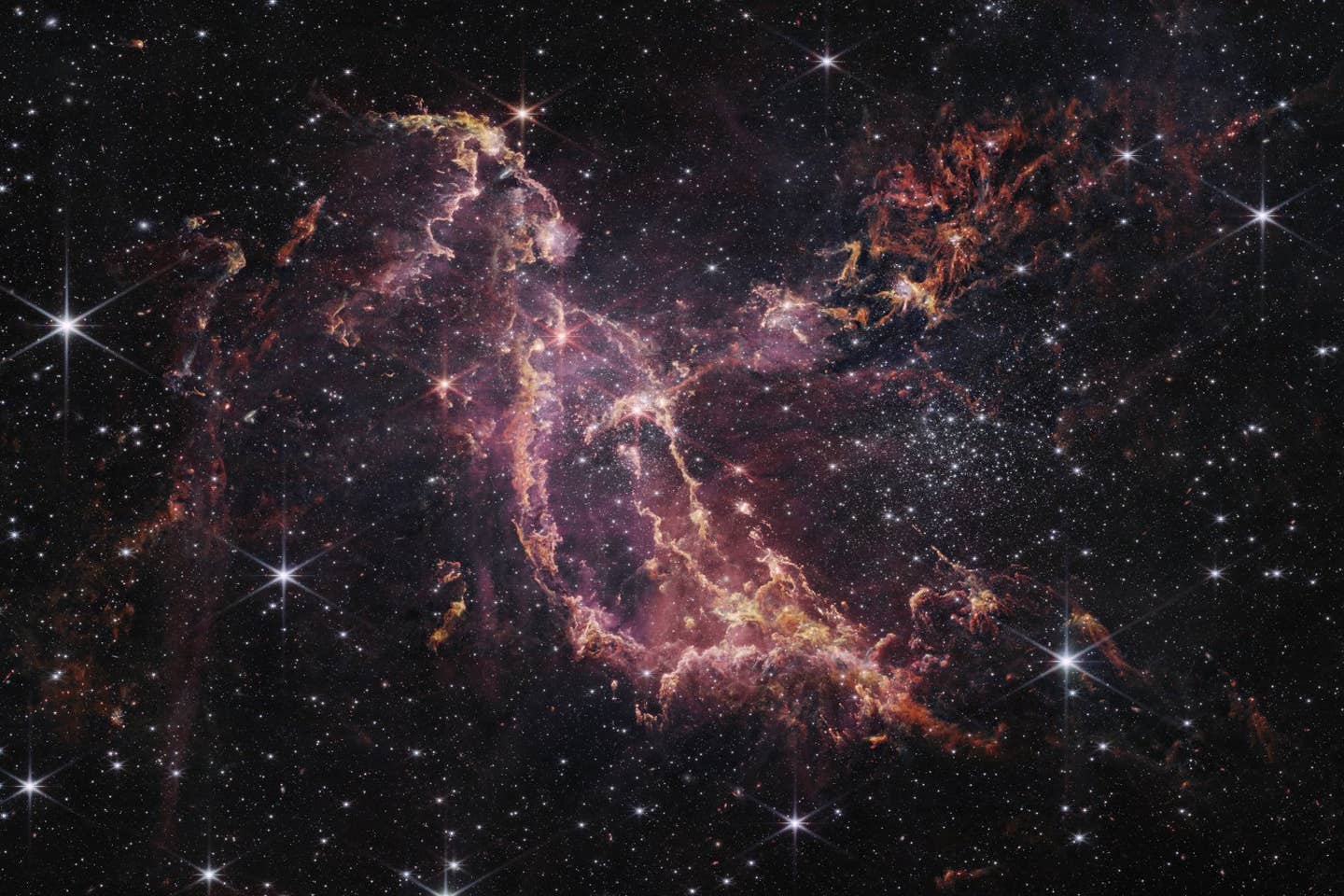What ‘fluffy clouds’ can teach scientists about how stars are born
New research on the Small Magellanic Cloud suggests early star formation may have occurred in “fluffy” clouds, unlike those in our galaxy.

Observations of the Small Magellanic Cloud reveal that early stars may have formed in “fluffy” molecular clouds. (CREDIT: NASA, ESA, Canadian Space Agency and Space Telescope Science Institute)
Stars emerge from vast regions of gas and dust known as molecular clouds. These stellar nurseries, often spanning hundreds of light-years, serve as the birthplace of countless stars, including those that eventually form planetary systems.
In our own galaxy, astronomers have found that these molecular clouds typically have elongated, filament-like structures, a characteristic believed to play a key role in how stars take shape.
However, a lingering question remains: Did stars form in the same way billions of years ago, when the universe was young? A recent study published in The Astrophysical Journal suggests that early star formation may have been quite different.
Researchers from Kyushu University, in collaboration with Osaka Metropolitan University, investigated a nearby galaxy, the Small Magellanic Cloud (SMC), to gain insight into the processes that shaped the first generations of stars.
The SMC, a dwarf galaxy about 200,000 light-years from Earth, is an ideal place to study star formation under conditions similar to those that existed around 10 billion years ago. It has significantly fewer heavy elements than the Milky Way, mirroring the early universe when only hydrogen and helium dominated cosmic landscapes.
A New Look at Molecular Clouds
Traditional observations of molecular clouds have suggested that their structure plays a key role in star formation. In our galaxy, filamentary clouds with widths of about 0.3 light-years appear to be a fundamental feature of star-forming regions.
Astronomers suspect that our own Solar System originated from such a structure. Gravity gradually pulled gas and dust into dense cores along the filament, leading to the formation of stars.
But was this structure always the same? The researchers turned to the powerful Atacama Large Millimeter / submillimeter Array (ALMA) telescope in Chile to take a closer look at the molecular clouds within the SMC. ALMA’s high-resolution imaging capabilities provided an unprecedented view of the cold gas and dust where stars are born.
Kazuki Tokuda, a postdoctoral fellow at Kyushu University and first author of the study, explains, “Even today, our understanding of star formation is still evolving. Understanding how stars formed in the earlier universe is even more challenging.
Related Stories
The early universe was quite different from today, mostly populated by hydrogen and helium. Heavier elements formed later in high-mass stars. We can’t go back in time to study star formation in the early universe, but we can observe parts of the universe with environments similar to it.”
By analyzing 17 molecular clouds in the SMC, the team found an unexpected result. While 60% of the clouds had the familiar filamentary structure seen in the Milky Way, the remaining 40% had a “fluffy” shape, lacking the elongated features thought to be crucial for star formation.
The Role of Temperature and Turbulence
Beyond their shapes, these molecular clouds exhibited another key difference—temperature. The filamentary clouds were significantly warmer than their fluffy counterparts. This variation suggests that molecular clouds start off as hot, filamentary structures but gradually cool over time, leading to changes in their shape.
Tokuda elaborates, “Initially, all clouds were filamentary with high temperatures due to cloud collisions. When the temperature is high, turbulence in the molecular cloud is weak. But as the temperature drops, the kinetic energy of incoming gas causes more turbulence, smoothing the filamentary structure and creating fluffy clouds.”
This shift in structure could have profound implications for star formation. Filamentary clouds break apart along their elongated structure, forming multiple stars. This process likely contributed to the formation of many Sun-like stars, complete with planetary systems. Fluffy clouds, however, may struggle to sustain the conditions necessary for low-mass star formation.
These findings suggest that the presence of heavy elements—metals, in astronomical terms—may be crucial in determining whether molecular clouds maintain their filamentary shape. Environments rich in heavy elements, such as the Milky Way, may favor star formation that leads to planetary systems. Meanwhile, in metal-poor environments like the early universe, the conditions for forming Sun-like stars may have been less common.
What This Means for Understanding the Universe
The results of this study challenge traditional assumptions about star formation. If filamentary clouds were not as prevalent in the early universe, then the initial mass function of stars—how many small or large stars form in a given region—may have been different from what we see today. Some studies suggest that low-metallicity environments might produce fewer low-mass stars, whereas others indicate that star formation remains relatively unchanged over time.
Observations of the SMC’s molecular clouds support the idea that star formation evolved alongside the chemical composition of galaxies. The delay in detecting outflows from massive protostars in the SMC compared to the Large Magellanic Cloud—a slightly more metal-rich neighboring galaxy—further underscores the influence of heavy elements on stellar birth.
CO emissions, which trace molecular gas, were harder to detect in the SMC because much of the hydrogen gas existed in a phase where CO was not present, making it difficult to observe directly.
Tokuda and his team emphasize that future studies should compare these findings with molecular clouds in more metal-rich environments, including our own Milky Way. “This study indicates that the environment, such as an adequate supply of heavy elements, is crucial for maintaining a filamentary structure and may play an important role in the formation of planetary systems,” he concludes.
The ability to study nearby galaxies like the SMC offers a rare opportunity to peer into the conditions that shaped the universe’s first stars.
By combining high-resolution observations with theoretical models, astronomers are gradually piecing together a clearer picture of how the cosmos evolved from a featureless expanse of hydrogen and helium to the vast, star-filled universe we see today.
Note: Materials provided above by The Brighter Side of News. Content may be edited for style and length.
Like these kind of feel good stories? Get The Brighter Side of News' newsletter.
Joshua Shavit
Science & Technology Writer | AI and Robotics Reporter
Joshua Shavit is a Los Angeles-based science and technology writer with a passion for exploring the breakthroughs shaping the future. As a contributor to The Brighter Side of News, he focuses on positive and transformative advancements in AI, technology, physics, engineering, robotics and space science. Joshua is currently working towards a Bachelor of Science in Business Administration at the University of California, Berkeley. He combines his academic background with a talent for storytelling, making complex scientific discoveries engaging and accessible. His work highlights the innovators behind the ideas, bringing readers closer to the people driving progress.



